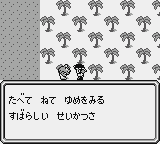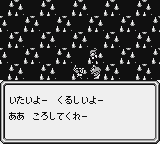Paradise and Hell in the Tower
Playing through Persona 3 gradually for nearly a month straight has really taken away my will to play; I’m considering just giving up on the main story and going on ahead to The Answer.
Perhaps as a reaction to Persona 3, in which the main dungeon is the endless-seeming tower of Tartarus, I started playing through Final Fantasy Legend, whose story centers around The Demon Tower.
The best feature of Final Fantasy Legend is the fact that it is mysterious – much like Drakkhen, I find myself coming back to it time and again if only in the hope I will find something new again this time around. FFL rarely disappoints. There are four “cardinal” worlds:
- The starting world, which is standard fantasy fare: three kings seek to unify the world.
- The ocean world, with pirates, wizards, and the dragon Seiryu’s undersea palace;
- The sky world, in which Byakko’s glider-planes seek domination over an ongoing rebellion;
- The post-apocalyptic world, in which the fiery phoenix Suzaku destroys all who stray from the few protected dwellings.
Of these four, the last has the most compelling plot, in which your party aids a small group in raiding an abandoned nuclear power plant to obtain the technology to neutralize Suzaku.
And yet, though these worlds have in themselves good sub-stories, still more miniature worlds hide in the Tower for the most adventurous to find.
In between the first two world, I found both Heaven and Hell.

The first seems like the Paradise that motivated so many to enter the tower. Its inhabitants, however, are devoid of motivation. All they do is “eat, sleep and dream”, and they claim “it’s a wonderful life”, but they have forgotten how to “live”. It is mere temporary pleasure, and not true happiness. As a side note, Opoona has a similar theme at a major junction in the story.

On the other hand we have the world of Hell, which is found in the same area. Here it’s clear the only life is suffering; though one inhabitant proclaims, “if I can bear this, the gods will take me to paradise!”, others only scream for you to kill them to relieve their misery. Perhaps due to your characters unexplained moral fiber, or perhaps due to the monsters guarding their prisoners (then again, perhaps because they were unable to implement it) you cannot do so.
Do these worlds signify anything? I’m not sure what the original intent was. To me, each seems to be critical of a world view: some simply seek pleasure without thought, and thus won’t progress in life. Others punish themselves now in the hope of a “someday” reward that will never come. Though a path out may be before their eyes, neither seems to notice; perhaps they believe that change will be worse.
But at the same time, both give a motivation and a sense of purpose to a revelation that comes only at the top of the (explorable) portion of the tower.
I recall there being stranger and stranger “side rooms” further up in the tower, too. The person behind both this and Final Fantasy Legend 2, which has a similar feel to it, is Akitoshi Kawazu, who has headed up most of the SaGa games. Playing through and enjoying both of these GB classics is almost enough to motivate me to try SaGa Frontier again.
As the screenshots indicate, I’ve been playing through in Japanese both for practice and just in case the translation is missing something; thus far it’s been spot-on aside from a few small things.